5 April, 2000
Dive Gear
Question 46: How big do icebergs get?
The weather is only mildly windy and rainy today so our group got in a
couple of dives in Hero Inlet, collecting a few target species of macroalgae
that we were low on. With shore diving, the tenders watch from shore to make
sure there are no problems and assist the divers in entering and exiting the
water. It is much easier to put all of the equipment on when you are not
standing in a rocking boat!
Before you put on your gear and hop into the water, you have to put your
SCUBA unit together. The tank holds the supply of compressed air that you
breathe while diving. We are not using any special mix of gasses. We are
using single steel 95-cubic-foot tanks with Y-valves, that are filled with
approximately 2400 psi of air.
The tank is cinched into the holder on the back of the buoyancy compensator
(BC). The BC is worn like a vest over the dry suit. It holds all the
equipment in place and can be filled with air to help us float at the surface.
It has lots of D-rings and quick release snaps to attach holders and gear to.
There is a hose over the left shoulder used to inflate and deflate the BC. I
have my dive knife zip-tied there for easy access. To help take the BC on and
off at the surface there are quick release clips on the shoulders. A large
velcro cummerbund and aquick release clip attach the two sides of the BC
together at the front.
The last and most important piece of gear that gets attached to the tank is
the regulator (or in our case, regulators). A regulator is the piece of
equipment that allows the diver to use the high pressure air from the tank; it
both reduces the pressure and gives air to the diver on demand (only when you
breathe in). There are two stages to the regulator. The first-stage has a
yoke that attaches to the tank valve. The first-stage reduces the air
pressure from the tank to 150 psi above the ambient (surrounding) pressure.
This intermediate pressure air travels down the hose to the second-stage that
is held in the mouth. The second-stage stops the air until the diver breathes
in. When the diver inhales, it then reduces the air to equal ambient
pressure.
The tank's Y-valve allows us to put two totally separate first-stage
regulators on the tank. This reduces the danger of a first-stage freeze-up.
Since each first-stage has a second-stage attached to it, we also have two
second-stage regulators, a secondary (back-up) and a primary. Both stages of
the regulator have air bleed systems to help keep the internal mechanics from
freezing. If our regulators freeze, they will usually freeze open, bleeding
lots of air rather than shutting off our air supply.
Also on the regulator are two power inflator hoses, one for the BC and one
for the dry suit. They both inflate with air from the tank. The other
attachment on one first-stage is the gauge console. This contains the
instruments that measure how much air remains in the tank (Submersible
Pressure Gauge), depth, direction (compass), and time. Our consoles have only
two units. One is the SPG and the other is a dive computer that tracks all
the other information and computes information about previous dives, current
dive and possibilities for future dives.
Answer 45: Sea water in Antarctica does not vary much in temperature between
summer and winter or with depth. South of 60 S, there is usually less than a
2 degree difference between seasonal temperatures. Throughout most of the
Southern Ocean there is only a 4-5 degree difference between the deepest
depths and the surface. The water is usually within the range of 2.0 to -2.0
C. Ice temperature (always below freezing) at the surface tends to be colder
as it is exposed to winter air temperatures while the underside of the ice is
near the temperature of the sea water (-1.5 to -2.0 C).

Clouds over Arthur Harbor and Marr Glacier.

Tank's Y-valve.
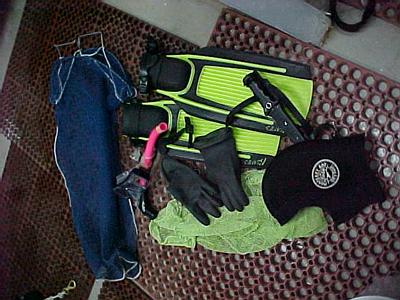
To keep all the loose pieces of gear together in the Zodiac, each diver places their own things (fins, gloves, hood, collecting bag, and mask) in a gear bag.
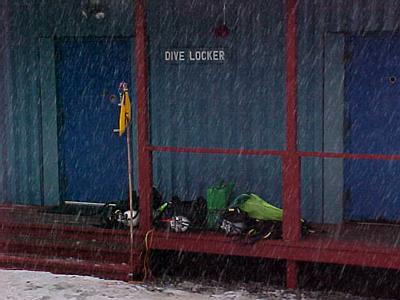
When the divers have assembled their SCUBA units and gear bags, they set them out on the porch of the dive locker (along with their weight harnesses) for the tenders to take down to the boat.
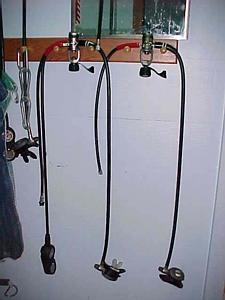
Regulators drying on rack. The second stages and gauge hand down, the first stages are at the top.

Attaching first stage to the tank's Y-valve. The BC is already attached to the tank.
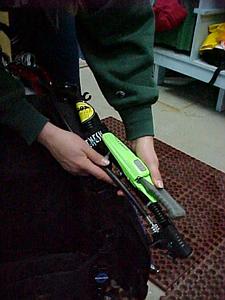
Shoulder hose of BC with power inflate hose and dive knife.

Both first stages attached to the tank.
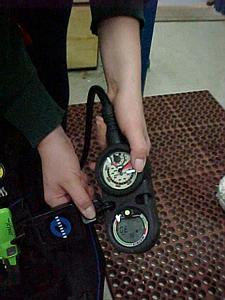
Attaching tether from BC to gauge and computer.
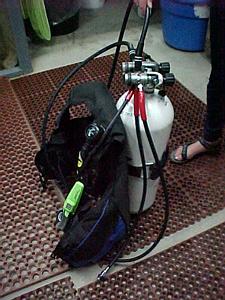
SCUBA unit all ready to go.

Contact the TEA in the field at
.
If you cannot connect through your browser, copy the
TEA's e-mail address in the "To:" line of
your favorite e-mail package.
|
